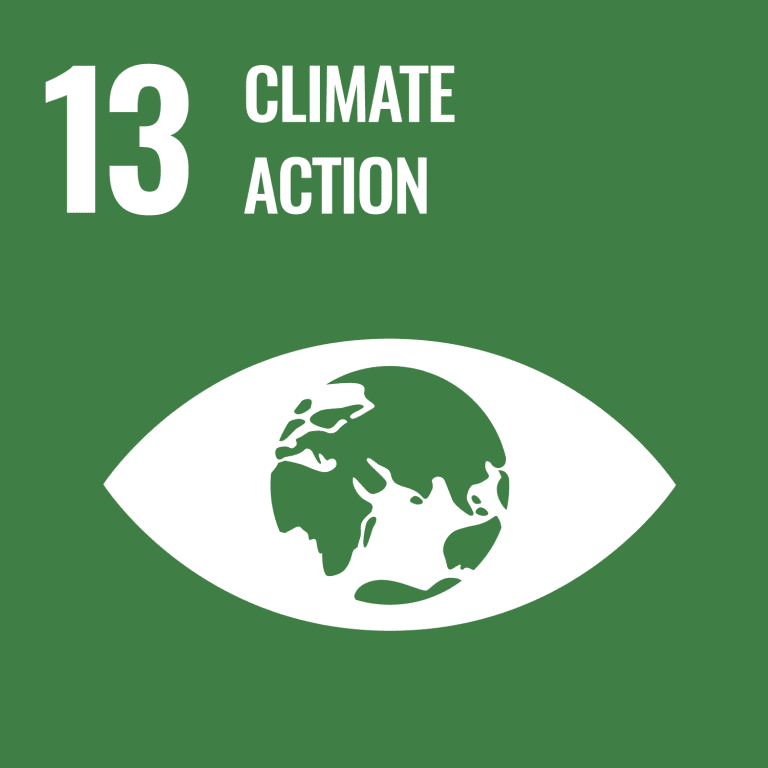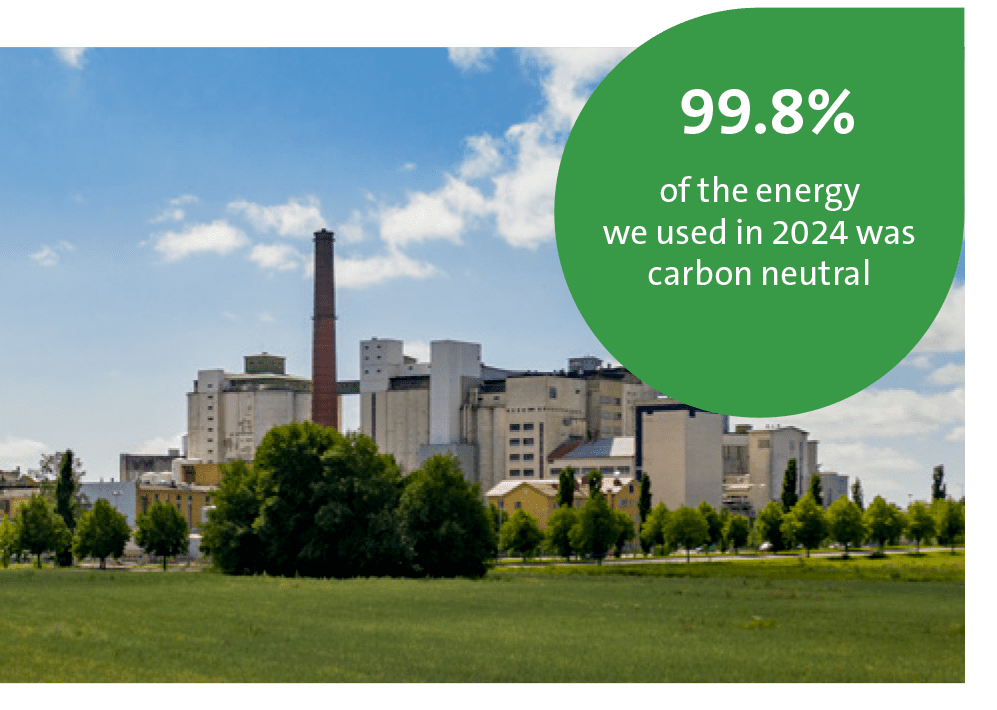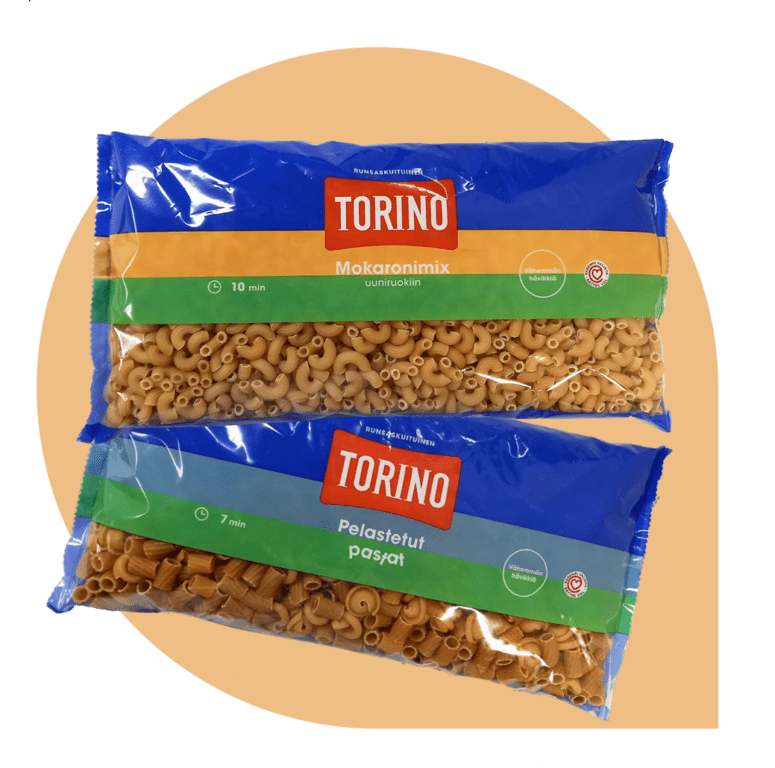Key objectives for 2022–2025
All Raisio’s own production is carbon neutral by the end of 2023.
We will report the (scope 3) CO2 emissions of Raisio’s value chain for 2022 and set a timetable and targets to reduce them.
We will reduce food loss and waste as well as utilise production sidestreams throughout the value chain.

Purchased and self-generated energy carbon neutral
2024 was the first year in which the purchased and self-generated energy used in our own factories was carbon neutral for the entire year.
In summer 2021, a heating plant was commissioned at the Nokia mill, which utilises oat hulls, a side stream of the mill’s processes, to produce heat and steam. In just a short time, the heating plant has proven to be a good way to ensure not only a responsible but also a cost-effective energy supply.
The heat and steam used by the factories at the Raisionkaari industrial area are supplied by the area’s own bioenergy plant.

So Raisio’s factories are now 100% carbon neutral?
In the big picture, yes, but strictly speaking, no. This is because we noticed that there are some forklifts and a bucket loader that run on LPG and fuel oil in our factories. Fuel oil is also used for some maintenance work. The amounts of fuel they require are marginal in our energy mix, but they do exist.
This observation shows that responsibility work is a continuous process and we are learning more and more as we move things forward. We have transitioned and will continue to transition to electric tools as the equipment is replaced.
With energy efficiency we ensure energy sufficiency
Energy efficiency is an important part of Raisio Group’s responsibility programme, and we have been involved in the Energy Efficiency Agreement for Industries since 2008. The agreement is currently in its second period, and the goal is to reduce the total energy consumption by 7.5 per cent by the end of 2025. The comparison is based on the 2015 level.
We are constantly looking for new ways to improve energy efficiency and save on electricity. For example, energy saving is always a factor when we invest in equipment, as more advanced equipment also often consumes less energy.
Scope 3 carbon footprint calculations
We have been working on Scope 1 and Scope 2 for a long time, and in recent years we have started to turn our attention to Scope 3 emissions. As part of this, we conducted our first ever survey of our largest subcontractors on their energy use and energy plans. The survey was sent to our 13 largest subcontractors, all of whom responded.
Two thirds of the electricity used by our subcontractors in their production comes from mainly renewable sources. Two thirds of the subcontractors use fossil energy as their main source of heat and steam. A few subcontractors supplement the fossil energy used to produce heat and steam with renewable energy, such as wind, solar or bio-based energy. Around 30% of respondents still use only fossil-based heat and steam.
Many of the subcontractors have plans to move towards renewable energy sources in the coming years, but some do not have any plans at all yet. The same is true for the reduction of Scope 1, 2 and 3 carbon dioxide emissions: some already have targets, others have no plans yet.
As expected, our survey of subcontractors shows that we are still far from carbon neutrality.
However, the issue needs to be gradually put on the priority list more broadly, at least for the largest subcontractors.
We have calculated our own indirect greenhouse gas emissions, or Scope 3 emissions, based on the Greenhouse Gas (GHG) Protocol’s Scope 3 guidelines. It includes indirect emissions related to our activities, originating from emission sources that are not owned or controlled by the company. Upstream emissions include indirect emissions before the manufacture of products, and downstream emissions include indirect emissions after the manufacture of products.
Our Scope 3 calculation shows that most of our Scope 3 emissions come from the production and cultivation of raw materials, which is typical for the food industry. Grains, our main raw material, account for around 60% of the total Scope 3 emissions.
The reduction of emissions requires long-term work with the supply chain
The calculation confirms our view that in the future we need to work even more closely than before with the supply chain, and primary producers in particular, to reduce overall emissions. With this in mind, we started a project in 2023 to collect more detailed farm-specific information to determine the carbon footprint of grains, particularly oats. We will continue calculations also in 2025.
The reduction of emissions requires long-term efforts by all parties. The collection of detailed data is arduous, and farming is subject to large annual variations in yields, so it takes time to see the effects of any changes. Compared to the 2023 level, total Scope 3 emissions have increased due to both higher raw material use and a different raw material mix in 2024.
We signed the Science Based Targets initiative commitment
In December 2024, Raisio committed to the international Science Based Targets initiative (SBTi), which aims to help companies and organisations set science-based targets to reduce greenhouse gas emissions. The SBTi aims to ensure that companies’ emission reductions are in line with climate science and the targets of the Paris Agreement. The aim is to limit global warming to no more than 1.5 degrees Celsius.
We are committed to setting near-term targets in line with the SBTi for both Raisio’s own operations (Scope 1 & 2) and our entire supply chain (Scope 3). We will start drawing up our concrete targets at the beginning of 2025. Our aim is to submit our targets for SBTi approval by the end of 2025.
We have been working persistently to reduce emissions for several years, even before we committed to the SBTi. With the SBTi targets, we are therefore looking not only to maintain and further develop our Scope 1 & 2 emission levels, but in particular to reduce our Scope 3 emissions.
We produce more from less
Food waste is generated in all parts of the food chain, including our factories. Factories also generate so-called side streams – material that is not needed in the product itself, but could be used elsewhere.
Our primary goal is to prevent waste: we want to improve our processes and practices to minimise the amount of waste. If there is waste, our aim is to ensure that edible food that is unfit for sale goes back into the food chain and inedible food waste is used for other purposes.
Below are examples of how we reduce food waste and make more efficient use of side streams:


